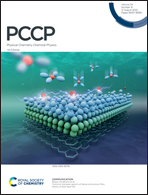Monitoring early-stage β-amyloid dimer aggregation by histidine site-specific two-dimensional infrared spectroscopy in a simulation study†
Abstract
Monitoring early-stage β-amyloid (Aβ) dimerization is a formidable challenge for understanding neurological diseases. We compared β-sheet formation and histidine site-specific two-dimensional infrared (2D IR) spectroscopic signatures of Aβ dimers with different histidine states (δ; Nδ1–H, ε; Nε2–H, or π; both protonated). Molecular dynamics (MD) simulations revealed that β-sheet formation is favored for the δδδ:δδδ and πππ:πππ tautomeric isomers showing strong couplings and frequent contacts between the central hydrophobic core and C-terminus compared with the εεε:εεε isomer. Characteristic blue-shifts in the 2D IR central bands were observed upon monomer-dimer transformation. The εεε:εεε dimer exhibited larger frequency shifts than δδδ:δδδ and πππ:πππ implying that the red-shift may have a correlation with Nδ1–H(δ) protonation. Our results support the tautomerization/protonation hypothesis that attributes Aβ misfolding to histidine tautomers as a possible primary initiator for Aβ aggregation and facilitates the application of histidine site-specific 2D IR spectroscopy for studying early-stage Aβ self-assembly.



 Please wait while we load your content...
Please wait while we load your content...